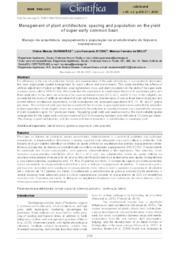Management of plant architecture, spacing and population on the yield of super early common bean.
Management of plant architecture, spacing and population on the yield of super early common bean.
Author(s): GUIMARÃES, C. M.; STONE, L. F.; MELO, M. F. de
Summary: For efficiency in the use of production factors and maximization of the yield of cultivars, it is essential to determine the most appropriate spatial arrangement for each cultivar and environment. This study identifies the effects of artificial adjustment of plant architecture, spacing between rows, and plant population on the yield of the super early common bean cultivar BRS FC104. We conducted the experiment in randomized blocks with subdivided plots and three replicates. In the plots, we assessed the spacing between rows (22.5, 45.0, and 67.5 cm). In the subplots, we considered the levels of artificial adjustment of plant architecture (maintenance of one or three lateral branches and control without architecture adjustment). In the subsubplots, we assessed populations of 6, 11, 16, and 21 plants per meter. The number of pods per plant increased with the increase in spacing between rows and with the reduction in plant population. Grain weight, in turn, increased with the reduction in spacing between rows and with the increase in plant population up to 14.7 plants per meter. Regarding grain yield and seed economy, the most suitable spatial arrangement for the super early cultivar consists of a 22.5 cm spacing between rows with about 12 plants per meter. The change in plant architecture, with the removal of lateral branches, is not effective to maximize yield.
Publication year: 2020
Types of publication: Journal article
Unit: Embrapa Rice & Beans
Observation
Some of Embrapa's publications are published as ePub files. To read them, use or download one of the following free software options to your computer or mobile device. Android: Google Play Books; IOS: iBooks; Windows and Linux: Calibre.
Access other publications
Access the Agricultural Research Database (BDPA) to consult Embrapa's full library collection and records.
Visit Embrapa Bookstore to purchase books and other publications sold by Embrapa.

